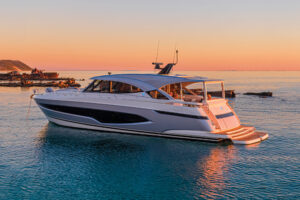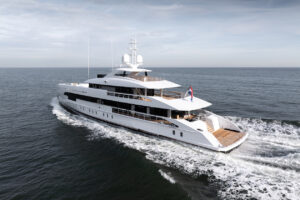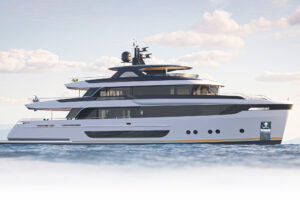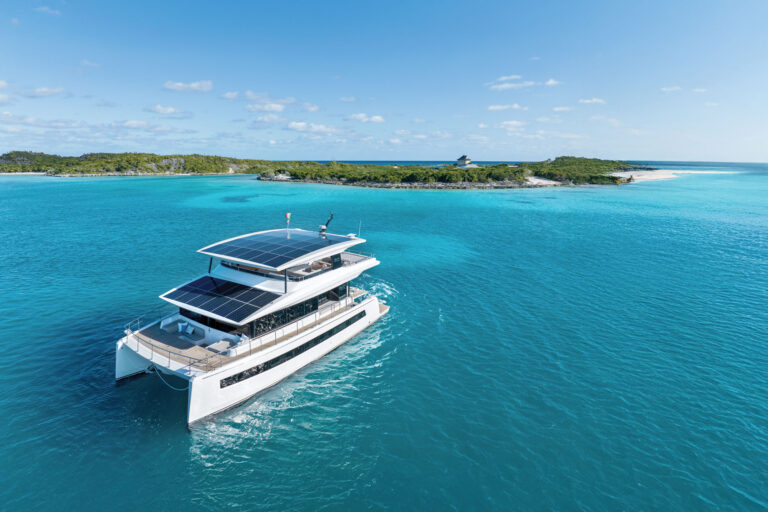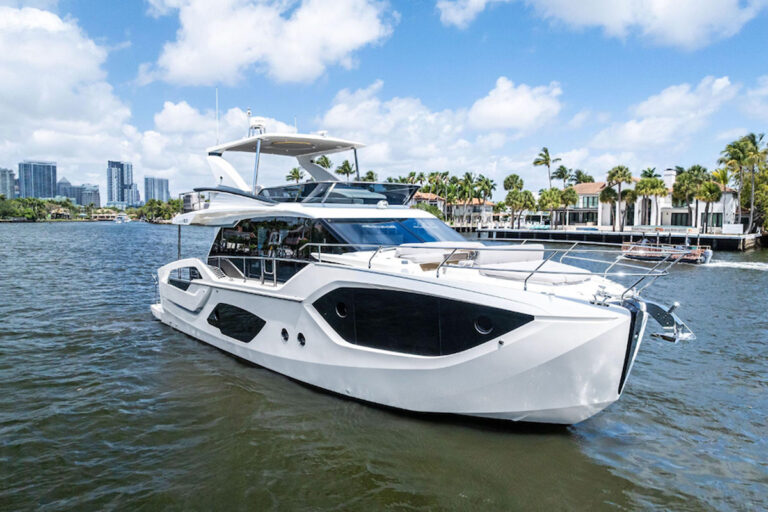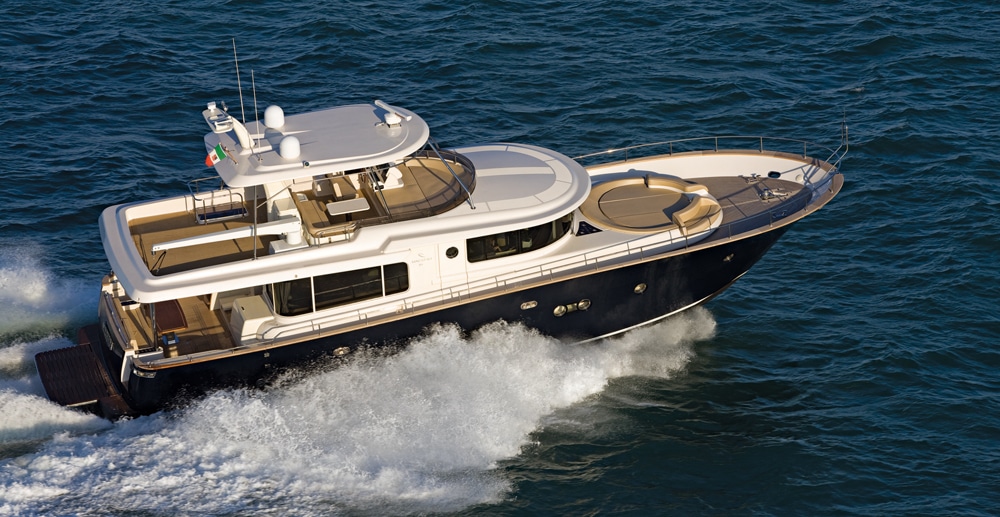
Apreamare Maestro 65 Americas Series
Imagine stepping on board a new yacht at a boat show and, instead of encountering a broker who seems as if he would be just as happy selling RVs in Spokane, meeting somebody as enthusiastic as you are about boats. What if that Type A individual giving you a tour was driven into the boatbuilding business by a deep passion for cruising, being on the water and simply messing around with boats? If you happened to pay a visit recently to the new Maestro 65 Americas Series built by Apreamare, chances are just such an individual — the enthusiastic Marc-Udo Broich, CEO and president of Maestro Yachts — greeted you.
Broich is a chronic entrepreneur and serious boater, importing Aicon Yachts until 2007. Today he beams with excitement while explaining how Apreamare is once again independent (it was formerly part of the Ferretti Group). Last April the yard returned to the control of the founding Aprea and Polio families, who date back to the company’s inception in 1849. The root of Broich’s excitement is the genesis of the Maestro 65 Americas Series — fine boats for the European market when originally launched in 2006 that the reinvigorated management team just made a whole lot better. The hull had been designed by Italian naval architect Umberto Tagliavini, with a house and interior arrangement by Gianni Zuccon, who also planned many of Ferretti’s yachts. One of those who saw this original version was Broich while he was looking for new opportunities. He liked the high-freeboard hull, which made it an ideal heavy-weather boat, and the open three-stateroom interior arrangement. But the minimalist design, which reflected European tastes, didn’t seem appropriate for the American market.
In the Mediterranean, yachtsmen spend as much time off the boat as on it, preferring for instance to eat ashore so much that the galley is often an afterthought. Crews usually operate boats, and owners use them as floating hotels, not cruising platforms. For instance, the aft deck of the 65 had only a couple of aft-facing bench seats; the upper deck had a small helm, some more bench seats (no table) and space for a tender and davit aft of the centered radar arch. (It didn’t skimp on the sun pads, however). Americans, Broich reasoned, are more hands-on than their European counterparts. A husband-wife team can easily handle a 65-foot boat, and Americans like to do more things on board, like cooking, cruising and simply enjoying.
It wasn’t until 2009, when Apreamare separated from Ferretti, that Broich signed on as the U.S. and Americas distributor, with the assurance he had freedom to make changes. “I liked the openness, the high freeboard, the seaworthiness of the boat. The basics were there,” he recalls. It had a very high 8-foot, 6-inch freeboard at the bow, a nice 18-foot, 8-inch beam that allowed wide side decks, and a moderate deadrise planing hull that could take the 65 comfortably north of 33 knots.
One feature that particularly impressed Broich was the main-deck window arrangement, which afforded an unusually expansive 360-degree line of sight from anywhere inside. Forward in the pilothouse the windows were aggressively vertical. The salon area aft was even more unusual: Several windows, including the two biggest windows on either side, dropped down, daring the cruiser to close his eyes, stick his elbow out the window and feel the 30-knot breeze like he did in that ’57 Chevy convertible he owned years ago.
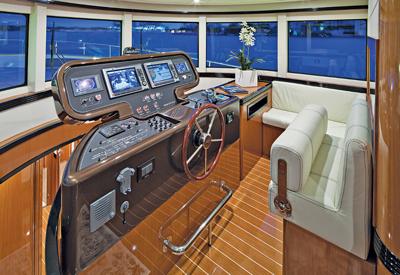
Using his vast personal cruising experience, Broich set about to make the boat more user-friendly for the Americas. Some changes were minor, such as installing side-deck doors and cleats amidships so boats could tie up side-to at a dock. (A passarelle, meant for the European market, also remains on the American version.) A control station was added on the aft deck to starboard to facilitate easy side-to docking. On the flying bridge, Broich installed a larger helm station capable of holding two computer monitors (the European version could hold only one), enlarged the seating area and added a dinette table.
Other changes were more significant, like extending the flying bridge deck all the way aft to the transom. The extension gives the owner the option of either installing a larger tender on the bridge deck or creating a bigger social space with portable deck chairs and furniture. Broich feels an owner operating his own vessel will probably not put a tender here (the davit is not standard) because it requires at least two people to raise and lower it. Instead, he enlarged and modified the swim platform so that it hydraulically lowers into the water. A PWC or RIB can easily be floated on or off the platform. A four-step hydraulic swim ladder emerges from under the aft deck on the port side of the stern. On the aft deck Broich added a dining table and another forward-facing bench seat for owners who like to eat aboard.
In the interior, a major shift involved bringing up the galley from down below (in the European version) to the main deck. Although it’s completely enclosed, separating the salon from the pilothouse forward, large picture windows fore and aft drop down so that whoever is cooking can still join the conversation. Both windows have a louvered shade in case the chef wants greater privacy. A full-size Isotherm refrigerator/freezer is standard, as are the four-burner Miele stove and oven and dishwasher. Cabinets line the galley fore and aft, and there are more under-counter cabinets too that provide plenty of stowage for long cruises. The galley even has its own door leading to the side deck. (The Maestro has doors on both sides of the house, unusual for yachts this size.)
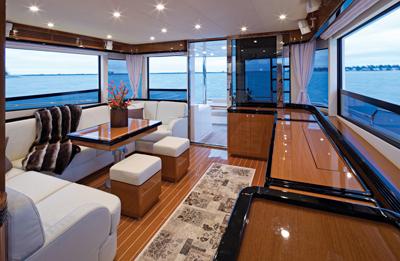
The lower helm station forward of the galley retains the Italian preference for style, including an interesting mounted instrument panel capable of holding up to four displays and conveniently placed switches on flat panels to either side of the wheel. The only change Broich made involved switching aft-facing passenger seats outboard of the helm to forward-facing. In another touch of Americanization, there’s a pullout countertop next to the helm just large enough for a couple of small breakfast plates or a laptop computer. The vertical windows provide a 180-degree line of sight and virtually no reflective glare, a problem more common in sloped windows.
Getting to the three staterooms means taking a curved stairway to port of the helm station. As you reach the bottom you can turn back and look up at the helm high above — the headroom here is at least 12 feet, an astonishing amount for a yacht this size. At the base of the stairs, as part of the foyer to the staterooms, one can have either a single berth/sofa or a small office with a desk and drawers. (In the European version the space was a galley). The space can be enclosed with sliding doors for privacy.
The master stateroom is down several stairs aft and contains a king berth, a counter with vanity, drawers in every conceivable space (even a laundry hamper) and a head athwartships to port. The head location narrows the master a bit but allows for more space for the guest staterooms. A second stateroom forward to starboard includes twin beds, a hanging locker and a bulkhead-mounted television. The larger guest stateroom is forward, tucked in the bow. There’s sufficient space to maneuver around the centerline bed, but the cost of such a flared, narrow bow is a bit of space sacrificed around the forward berth.
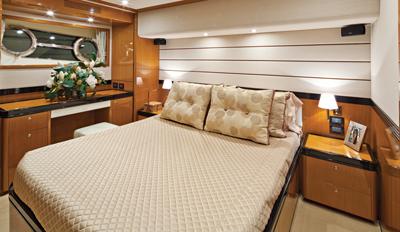
It’s an easy trade-off to make, however, because the Maestro’s high, flared freeboard forward and narrow stem make for an exceedingly dry, smooth ride even in rough conditions. Standard power is twin 1,100-horsepower MAN V-10 diesels that take the boat up to 30 knots. The engine-room headroom is more than six feet, and systems that regularly need inspections, such as fuel filters and sea strainers, are all plainly visible on the forward bulkhead. The boat we tested had the optional 1,360-horsepower MAN V-12 diesels, and on a nice day off Miami we registered 33.8 knots using trim tabs, a good-looking speed that reinforced Broich’s objection to the word trawler to describe the boat. “This boat isn’t meant to be a trawler,” he insists. “It’s meant to be a fast boat, to get you to certain places.” Standard fuel capacity is 1,585 gallons in three tanks, two just forward of the engine room and one underneath. (There’s an option for two additional 264-gallon tanks farther aft.) The top 34-knot speed gives the Maestro a range of 470 miles with the standard fuel capacity; if it runs at 30 knots (2,100 rpm), the range is about 540 miles. It’s significant that despite all the additional weight on the American model (lengthened bridge deck, marble countertops in the bathrooms, 400 feet of anchor chain forward — that’s standard, by the way — and other heavy items), the yacht we tested went only about a knot slower than the lighter European version.
For all the changes made to the American version, the company still offers a lot of options. The interior paneling, which on our test boat was a light teak with African wenge trim, can be ordered in mahogany, cherry or one of several other exotic wood choices. Gloss, semigloss or a matte finish can be ordered. A single 23 kW Mase generator is standard, but a second one can be installed. Items such as Bose stereos in all staterooms, extra ice makers and wine coolers are also optional.
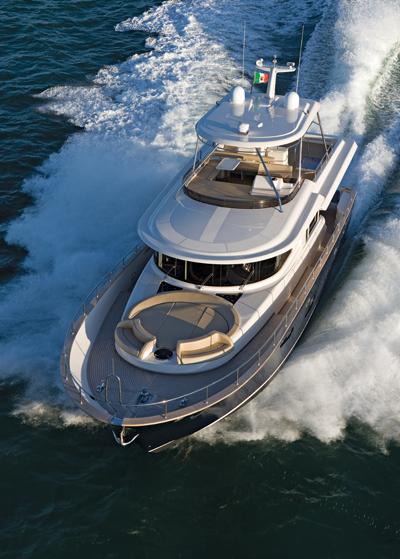
Those drop-down salon windows, however, are standard items. Broich corrected me when I said that the open windows meant this was a boat intended primarily for the tropics. In warm climates the boat would need air conditioning so the windows would likely be closed. The Maestro 65 will also be appreciated in New England or Puget Sound, when the evenings’ cool and soft breezes waft across the vessel. What better way to enjoy the moment than to open all the windows and feel the outside on your skin, yet know you’re inside, lost in conversation or a good chess game. It’s hard to think of a better way to spend some time, knowing that you’re on one of the most interesting boats under 70 feet launched this year.
LOA: 66’2″
Beam: 18’8″
Draft: 4’11”
Displ.: 54 metric tons
Fuel: 1,585 gal. (two additional 264-gal. tanks optional)
Water: 264 gal.
Standard Power: 2 x 1,100-hp MAN V-10 diesels
Test Power: 2 x 1,360-hp MAN V-12 diesels
Base Price: $2,950,000 (may vary based on exchange rate)
**Maestro Yachts LLC, 954-651-9210; www.apreamareyachts.com
**

